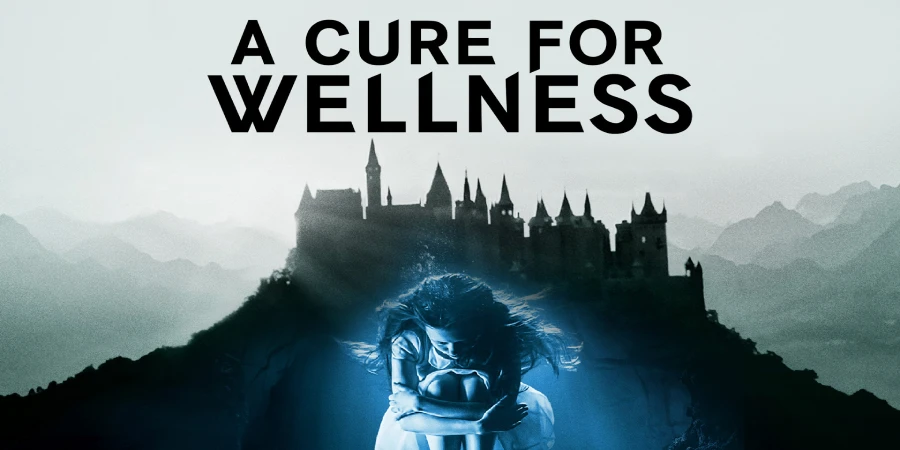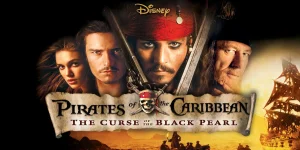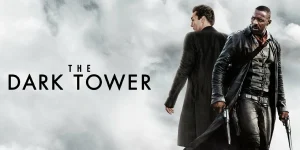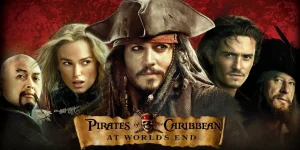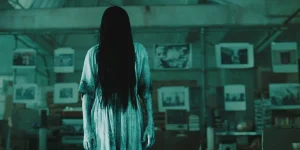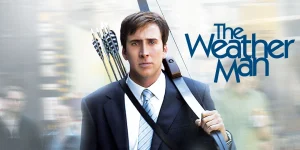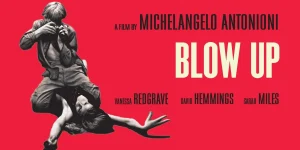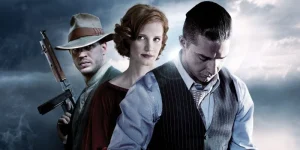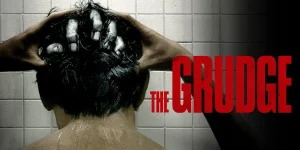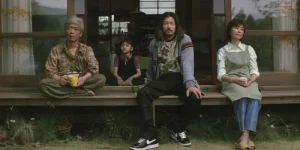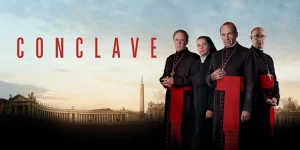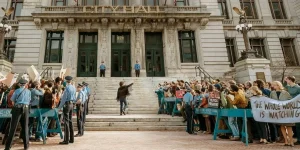A Cure for Wellness is a psychological horror thriller directed by Gore Verbinski, known for The Ring and the Pirates of the Caribbean series. With its haunting visuals and unsettling atmosphere, the film is a slow-burning descent into madness and mystery, drawing inspiration from Gothic horror, German expressionism, and psychological thrillers. It tells a story that’s equal parts eerie fairy tale and corporate nightmare.
Table of Contents
ToggleDetailed Summary
Corporate Scandal and the Mysterious Letter
Lockhart (Dane DeHaan) is a young, ambitious executive sent to retrieve his company’s CEO, Roland Pembroke, from a mysterious wellness center in the Swiss Alps. The CEO had written a cryptic letter from the facility, declaring he’s found “the cure for wellness” and won’t return. Lockhart’s bosses are suspicious, fearing an upcoming merger could fall apart if Pembroke doesn’t return to sign key documents.
The facility—a castle-like spa nestled in the mountains—is isolated, pristine, and run with an eerie calm by Dr. Volmer (Jason Isaacs). The patients all claim to be recovering from stress, overwork, and toxins—but something about them feels disturbingly off.
An Accident and a Forced Stay
Soon after Lockhart arrives, he gets into a car accident and finds himself with a broken leg—stuck at the center, now a patient. As he begins treatment (which includes drinking large quantities of the spa’s supposedly therapeutic water), he notices strange behaviors from the staff and patients, inconsistencies in their stories, and disturbing hallucinations.
He meets Hannah (Mia Goth), a pale and ethereal young woman who seems different from the others—innocent, childlike, and unfamiliar with the outside world. Volmer is clearly protective of her, and hints are dropped about her special role at the center.
The Dark History of the Spa
Lockhart digs into the facility’s past and learns about a dark legend: 200 years ago, the baron who lived there performed experiments to create a “pure bloodline.” He married his own sister, but the townspeople revolted, burning the castle and supposedly killing the baron and his unborn child. However, rumors persist that the child survived.
It’s revealed that the water at the spa contains a toxic substance from underground aquifers. Though deadly to humans, eels can survive in it. The spa uses this water to filter “essence” from humans—essentially liquefying them to create a life-prolonging serum.
Lockhart’s Descent Into Madness (Or Clarity?)
As Lockhart’s health deteriorates and his sense of reality collapses, he uncovers grotesque secrets: the staff aren’t patients but test subjects, victims of experiments meant to extract the life-extending elixir. Pembroke is dead, or close enough, his body having been harvested. Lockhart tries to escape but is dragged back repeatedly, hallucinating his past traumas and experiencing a full mental breakdown.
Volmer’s True Identity
In the final act, Lockhart discovers the ultimate horror: Dr. Volmer is the baron from the 200-year-old legend. He’s been using the elixir to remain alive for centuries. Hannah, shockingly, is his daughter—born from incest and raised in isolation for use in continuing his “pure bloodline.”
Volmer attempts to impregnate Hannah in a nightmarish ritual, but Lockhart intervenes. In the ensuing fight, the castle is engulfed in flames. Volmer’s grotesque, partly burned face is revealed, and he is finally killed—impaled and devoured by eels.
Movie Ending
As the castle burns, Lockhart and Hannah flee. On the way down the mountain, they are met by Lockhart’s company board members, who have arrived to retrieve him. Instead of rejoining the corporate world, Lockhart rejects their offers. His face—now calm, maybe even twisted in a new way—breaks into a strange smile. He rides away on a bicycle with Hannah behind him, the implication being ambiguous: Has he escaped the madness, or has he embraced it?
This ending leaves viewers unsettled—unclear if Lockhart is free, insane, or permanently changed by the trauma he endured. It also leaves open whether he now knows or possesses the secret of the elixir.
Are There Post-Credits Scenes?
No, A Cure for Wellness does not have any post-credits scenes. Once the film ends, the story is complete, albeit hauntingly ambiguous.
Type of Movie
- Genre: Psychological Horror, Gothic Thriller, Mystery
- Tone: Atmospheric, unsettling, slow-paced, cerebral
Cast
- Dane DeHaan as Lockhart
- Jason Isaacs as Dr. Heinreich Volmer
- Mia Goth as Hannah
- Harry Groener as Pembroke
- Celia Imrie as Victoria Watkins
Film Music and Composer
The score was composed by Benjamin Wallfisch, known for his haunting work in It and Blade Runner 2049 (with Hans Zimmer). The music in A Cure for Wellness blends eerie lullabies with ominous orchestral swells, perfectly matching the unsettling tone of the film.
Notable: The recurring theme “Hannah and Volmer” is a hauntingly beautiful piece that underscores the twisted father-daughter dynamic and the film’s tragic core.
Filming Locations
- Hohenzollern Castle, Germany – Used for exterior shots of the wellness center. Its medieval Gothic appearance adds to the fairytale-gone-wrong aesthetic.
- Babelsberg Studio, Potsdam, Germany – Used for interior scenes and special effects.
- Swiss Alps – Used for establishing shots and mountain sequences.
The isolation and historical weight of these real locations helped intensify the film’s themes of entrapment, madness, and timeless evil.
Awards and Nominations
While the film didn’t receive major awards, it was praised for:
- Best Production Design nominations from various critics’ circles
- Fangoria Chainsaw Awards nomination for Best Wide Release Film
- It received strong critical notice for cinematography, thanks to Bojan Bazelli’s dreamlike visuals
Behind the Scenes Insights
- Gore Verbinski described the film as a mix between Shutter Island, Dracula, and The Shining.
- The eerie eels were a mix of CGI and real water snakes handled on set—DeHaan reportedly hated filming those scenes.
- Jason Isaacs embraced the villain role, going method for many scenes, even staying in character between takes.
- The “tooth extraction” scene was so graphic during test screenings that some viewers fainted.
- Filming took nearly five months, much of it in cold, remote mountain locations.
Inspirations and References
- Thomas Mann’s “The Magic Mountain” – A novel about a young man who visits a sanitarium in the Swiss Alps and becomes entranced by the mysterious place.
- H.P. Lovecraft – Themes of ancient evil, madness, and unknown science.
- 19th-century Gothic novels – Including Dracula and Frankenstein, especially in the themes of medical experimentation and incest.
- German expressionist films – The visual style often echoes works like The Cabinet of Dr. Caligari.
Alternate Endings and Deleted Scenes
No alternate ending was ever confirmed by the studio, but several deleted and extended scenes exist:
- A longer version of the village pub scene, which gave more backstory about the baron’s legend.
- A disturbing subplot where a patient had begun turning into an eel-like creature was reportedly cut for pacing and tone.
Book Adaptations and Differences
The movie is not based on a book, but heavily inspired by literature. It does not have a novelization or direct source material but owes thematic debt to The Magic Mountain, Shutter Island, and Eyes Without a Face.
Memorable Scenes and Quotes
Key Scenes
- The initial train ride to the Alps with the foreboding mountain tunnel.
- The tooth extraction scene—visceral, squirm-inducing horror.
- The eel-filled sensory deprivation tank sequence.
- Volmer’s incestuous ritual attempt with Hannah in the burning castle.
- Lockhart’s final smile—chillingly ambiguous.
Iconic Quotes
- Lockhart: “There’s a sickness inside us, rising like the bile. It’s in our blood… in our brains… in our souls.”
- Volmer: “Only when we accept that we are already dead, do we begin to cure ourselves.”
- Victoria Watkins: “Do you know what the cure is? You don’t even know what the disease is.”
Easter Eggs and Hidden Details
- The baron’s coat of arms can be spotted in numerous places throughout the film, including the spa’s branding—hinting at Volmer’s identity early on.
- The villagers use old-world dialects and wear 19th-century clothing, subtly implying they too are stuck in time.
- The sound of trickling water is constantly present in background audio, symbolizing the omnipresence of the “cure” and the eels.
Trivia
- Dane DeHaan had to lose 15 pounds for scenes where Lockhart appears emaciated.
- Over 300,000 gallons of water were used during production.
- The film’s trailer was initially removed from YouTube due to disturbing content but later reinstated with a warning.
- Mia Goth had to undergo swim training for underwater scenes despite having aquaphobia.
Why Watch?
If you enjoy cerebral horror with a slow pace, unforgettable visuals, and a creeping sense of dread, A Cure for Wellness delivers a hypnotic and grotesque experience. It’s not a jump-scare fest—it’s a psychological labyrinth that asks uncomfortable questions about wellness, mortality, and the cost of purity.
Director’s Other Movies
- The Ring (2002)
- Pirates of the Caribbean: The Curse of the Black Pearl (2003)
- Rango (2011)
- The Lone Ranger (2013)
- The Weather Man (2005)

